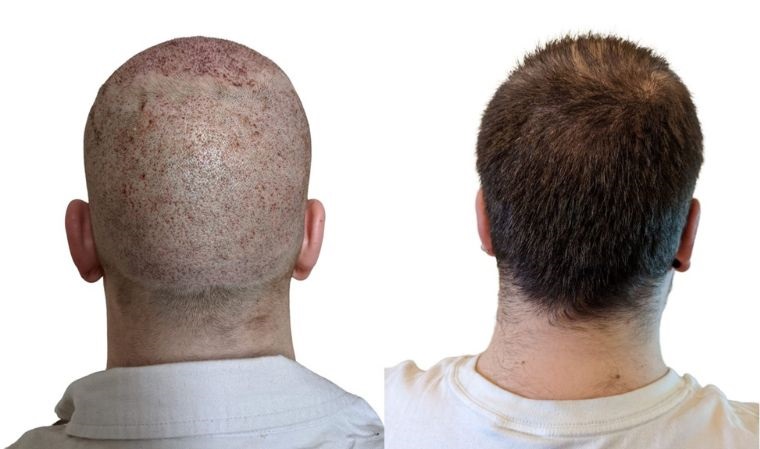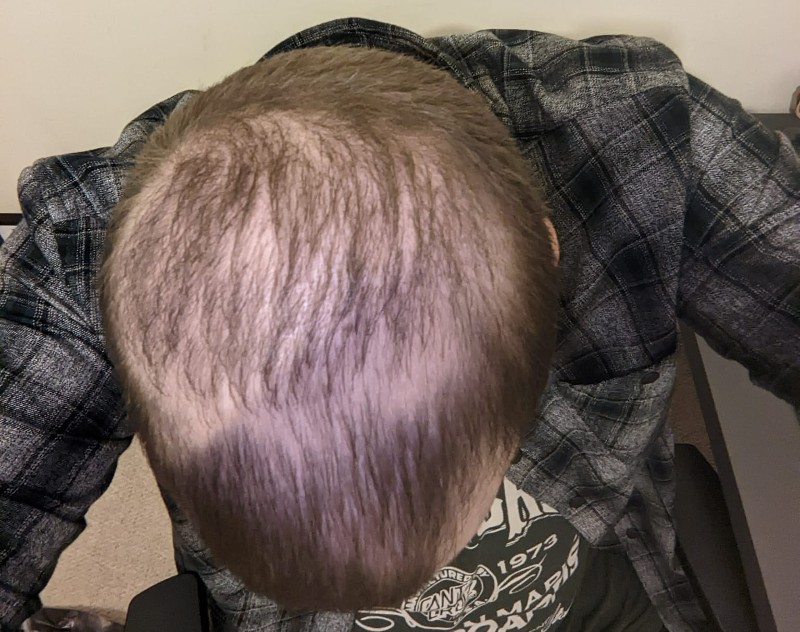
A hair transplant is a significant investment in both time and money, so it’s natural to wonder whether it will be worth it in the long run. Fortunately, in most cases, hair transplants are permanent, but this is not a guarantee without proper care.
In this article, we’ll examine why hair transplants should last a lifetime, why some people may need a second transplant, the reasons hair transplants can fail, and how long they can last.
To provide an accurate picture, I’ve looked at testimonials from hundreds of people who’ve had hair transplants, including Henry, who underwent the procedure a few years ago. He has shared everything his surgeon told him about why his transplant is likely to last forever.
In this article we’ll look at:
- Why hair transplants should be permanent
- Why some people choose a second transplant
- Reasons hair transplants can fail
How long do hair transplants last? Key points
- Because hair transplants use donor hair that is resistant to DHT, the new hair usually lasts forever
- Donated hair behaves just like hair normally would – including re-growing if you lose it for another reason in future (e.g. chemotherapy)
- Second transplants may be needed to replace thinning hair that had already existed at the transplant site
- Transplanted hair will fall out – this is normal, the follicle will continue to then regrow new hair in its place
Is a hair transplant permanent?
Hair transplants are normally permanent and typically don’t require a follow-up treatment. Donor hair that is resistant to the cause of hair loss will continue to resist it even when it’s moved on your head, so the follicle won’t then die in its new location.
The advantage of a hair transplant is that it should last forever because the hair maintains the quality of the donor area. Hairs taken from the back of the neck, where follicles aren’t as sensitive to DHT, will be equally as resistant in their new location.
This is the reason that people who do go bald retain the ‘horseshoe’ and are bald on top, with hair at the back and sides. For whatever reason, DHT just doesn’t affect those hair follicles in the same way as those on the top.

It’s not that DHT affects the area of your head – moving hair follicles doesn’t then mean that those follicles will suffer the same fate as those already lost. It’s just that the hair you did have growing on your scalp was already more susceptible to DHT.
So when you move DHT-resistant hair from the back of your head onto the top, it retains that natural resistance to DHT and so won’t die off, meaning the transplant should be permanent.
Is a hair transplant worth the money?
Whether a hair transplant is worth the money or not will depend on your personal circumstances and emotional/mental reaction to hair loss. Considering that hair transplants are typically permanent and can prevent the need to pay for ongoing medication, they usually offer decent value.
It’s not a simple question to answer though.
A hair transplant is not something to be taken lightly. The actual transplant itself takes a long time – often most of a day, and in some cases, two procedures may be needed. Then there’s the recovery time, with the impact on sleep, and of course the financial burden too.
If you’re someone who hasn’t tried the shaved-head look then it might be a lot simpler to just avoid the treatment, save your money and embrace the bald style.
But just because I’ve been shaving my head for 20 years, that doesn’t mean I think it’s the only solution and that it’s right for everyone. Some people will be much happier with a head full of hair, and a transplant can sometimes be the ideal solution.
My conversation with Henry gave me an insight into the experience of a hair transplant patient. The running total of Henry’s regular appointments to maintain his hair system was adding up to the same level as a transplant would cost. It made financial sense to look into the transplant option.

Rogaine – the most popular brand of minoxidil medication – costs around $30 per month. So in 11 years, that’s $4,000 you’re paying for the treatment just to hold your hair loss at bay.
I was fascinated by the story of Victor, who used Finasteride and Minoxidil for six months, but quit after seeing his mental health suffer:
In Victor’s words, if you’re “self-medicating for something that’s not a sickness” and simply worrying about what will happen when you stop, it’s time to look for a more permanent solution that’s better for you.
That could mean shaving your head, like Victor and I did, or seriously looking into a hair transplant.
The average cost of a hair transplant varies in the US because it depends on how many follicles need moving, but the lower end of the average is $4,000. So a transplant could actually work out to cost less since it’ll last 10, 20, or even 30+ years (depending on how early in life you get it done).
And there’s no risk of any DHT-blocker side effects then either.
Does transplanted hair fall out?
Transplanted hair will often fall out a few weeks or months after treatment – this is normal and not something to panic over. Once the follicles have bedded into their new home they will often shed the hair they’ve grown and begin afresh.
When you have a hair transplant, you’ll usually have shaved hairs that are very small being relocated to the transplant area. This essentially kills the hair, but not the follicle – so the hair will remain for a little while.
Then, after a short recovery period, the patient goes through a period of ‘shedding’ when the dead hair falls out, but the healthy follicles regrow new hair.
This shedding phase generally lasts between 2-12 weeks, and regrows over the next 4-12 months. The hair can be quite sparsely populated at first, but thickens as it grows.

Do hair transplants fall out and never regrow? It’s possible, but rare.
Don’t assume the worst if you notice your hair falling out after a transplant – just give it some time and it should start to grow again, getting thicker and thicker until you get to around 18 months post-transplant.
How long do hair transplants take to heal?
Typically a hair transplant will take a few weeks to fully heal but then much longer for the full results to come through. Hair transplants can take months for the hair to properly regrow, up to a maximum of 18 months for full results.
There’ll likely be some mild discomfort, potentially mild pain, in the first couple of days. After all, you’ve just had a load of hair follicles cut out of your head and then re-inserted elsewhere in your head. It’s only natural for some swelling and scarring.

If you’ve had an FUE transplant it’ll settle in 1-2 days, while FUT transplants can take a little longer, up to 12 days maximum.
The swelling and scarring will settle down over the course of the next couple of weeks and you’ll soon be able to get back to sleeping normally – but in that initial couple of weeks, you’ll need to be propped up to avoid putting pressure on the scalp.
You’ll then shed the hair, before the new hair starts to grow through. Be patient as this can take a while and the results will be worth it in the end.
Do you need to use minoxidil after a hair transplant?
For most people, a hair transplant is seen as a replacement for using minoxidil, although some people prefer to keep using it to help minimize hair loss in the follicles that weren’t transplanted. Minoxidil should be avoided for a couple of weeks after a hair transplant, regardless.
A lot of people choose to get a hair transplant because they don’t want to be using medication for the rest of their lives, or they’re concerned about the side effects.
And typically a hair transplant doesn’t then need sustained medication to work. In most cases, once you’ve had the procedure it will last permanently without the need for minoxidil.
But there are some people who have a hair transplant relatively early before their hairline has completely settled, and so they may be concerned that even after the transplant they may continue to lose hair.

They may opt to get the transplant earlier to preserve their look, even though it means potentially needing to take minoxidil afterward to keep the remaining hair as thick as possible for longer.
From a financial perspective, it’s best to let your hairline completely settle before you get a hair transplant but I get that you might not be comfortable with that. Hair loss happens over a long time, and the ‘balding’ look is not one I’d recommend.
So in summary, you shouldn’t need to take minoxidil after a hair transplant, but be aware that if you have had an early transplant then there’s a risk your new results might only be temporary and you may see thinning again.
Why do some people have two hair transplants?
There are some people who choose to have a second hair transplant later in life in order to preserve the thickness of their hair. This is sometimes needed if the first transplant is done early, before the hair loss has completely settled.
Again, it’s understandable for people to want to get a hair transplant as soon as possible, instead of waiting for their hair loss to be ‘complete’ (as in, when all the hair they were going to lose is gone and they’re left with only the DHT-resistant hair on the sides and back of the head).
So it may be the case that you get a hair transplant, and it works well, but then over time, you notice your hair thinning.
It won’t be as extreme as the first time, because the original transplant will help to keep the hairline intact – but it just won’t be quite as thick as it was. If that happens then yes, a second transplant is an option, depending on you having enough donor hair to give.
There are also lots of cases where there isn’t time to complete the transplant in a single session. Technically this is two transplants, but really it’s the same surgery split over two sessions:

Reasons why a hair transplant can fail
It is possible for a hair transplant to be rejected by the body but this is very rare. It typically occurs when a patient suffers from Lichen Planopilaris (LLP), a type of scarring alopecia that is responsible for fewer than 1% of hair loss cases in men.
There are a few other reasons a hair transplant could fail, but these aren’t medical and are often avoidable. The three main reasons for failure are:
- Graft rejection due to LLP
- Poor post-transplant care
- The inexperience of the surgeon
LLP should be noticeable before you get a transplant – it typically involves inflammation of the skin on the scalp where you’re losing hair. Always mention these symptoms to a clinic when discussing a hair transplant as they can advise on whether there’s an increased chance of failure.
With the second option, this one is likely on you – transplants can fail if you don’t follow the instructions of your surgeon to the letter. Your scalp is going to be very sensitive and delicate in the days following surgery and if you don’t protect it, all that hard work can quickly be undone.
Some causes of hair transplant failure are stress, poor diet, smoking, and drug use, as well as simple insufficient post-transplant care.
To avoid the third issue, just do your research and make sure you use a reputable clinic with a lot of (independent) positive reviews and testimonials. Remember to never just trust a testimonial on a clinic’s website (because how do you know they didn’t write it themselves?).
Failure odds are very low, as long as you disclose all your hair loss symptoms upfront, you stick to the aftercare plan, and you choose a client that is experienced.
What happens if you lose your hair for another reason after a transplant?
If you lose your hair for any other reason after you have had a hair transplant, it will behave just as if it was natural hair. So in most cases, it will regrow once you’ve addressed the cause of your hair loss.
Hair transplants are designed to tackle male pattern baldness and can be used for female pattern baldness too. In fact, plenty of female celebrities have had hair transplants.

It’s worth clarifying that, of all women who lose their hair, only a small percentage are suffering from non-hormonal pattern baldness that can be rectified with a hair transplant.
However, there are other reasons you could lose your hair, and these could affect you after you’ve had a hair transplant. Potential reasons include:
- Undergoing treatments for cancer such as chemotherapy
- Elevated stress levels
- Scalp infections
- Certain illnesses including STIs
With a healthy head of hair, you’ll normally see it regrow once you’ve either fixed the issue or completed your treatment.
And the good news is that the same should apply if you’ve had a hair transplant.
These issues aren’t killing your hair follicles. Instead, they’re hampering them from behaving properly. That’s the same whether it’s a follicle that is where it first grew in your head or one that has been relocated during a hair transplant.
Once the hair follicle is left to recover, it will usually get back to the job of growing your hair as normal.
While it’s true that some hair loss after a transplant is normal, don’t assume that all hair loss is just part of the process. It’s important to understand that there are some permanent causes of hair loss that could potentially undo the progress made during your transplant.
So, if you notice excessive or concerning hair loss, be sure to reach out to your doctor for further evaluation.
Usually, these issues are caused through rigorous cosmetic options such as perming your hair or dyeing it a different color.
Certain hairstyles that pull can damage follicles and cause traction alopecia. Coloring hair frequently will always risk damaging it, so the same applies if you’re doing these things to transplanted hair.
In short – don’t.
If you’ve just spent thousands of dollars getting a transplant, don’t kill it because you just have to have a certain hairstyle or shade. It’s better to have a head full of gray hair than a balding head and a bill for a transplant that you’ve ruined.
FAQs
In most cases an FUE hair transplant will be permanent. There may be a need for a second transplant or continued medication use if your pre-existing hair (that isn’t transplanted) continues to fall out, but transplanted hair will, in most cases, last your whole life.
An FUT hair transplant should last forever. There’s no difference between FUE and FUT hair transplants in terms of how long the results should last. Provided the donor hair takes, which it almost always does, then it will continue to grow for your lifetime.
Summary
A lot of life-changing treatments, such as laser eye surgery, have a limited lifespan. It’s a long time still, sure, but you’re paying a huge sum for something that isn’t permanent.
But that’s not the case with a hair transplant – for most people it’s a one-and-done thing, and once you’ve healed you can enjoy your new head of hair that you’ll have for life.
So while I would always advocate trying the shaved look out, if that’s really not something you’re into then why not consider a transplant if you’re losing your hair?
It’s definitely going to be better than trying to style out the balding look long-term.
If you’re considering it, then you’ll probably have more questions – why not check out my case study that answers the question ‘Do hair transplants hurt?’ next?
Drop any other questions or feedback you have in the comments, especially if you’ve had a hair transplant yourself.
Ultimately, if a transplant isn’t for you and the bald life is more your thing, you can join us at the Bald & Happy Facebook page or sign up for email updates.

